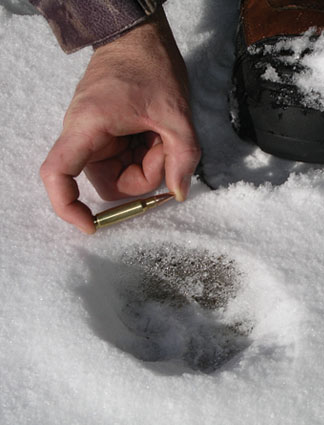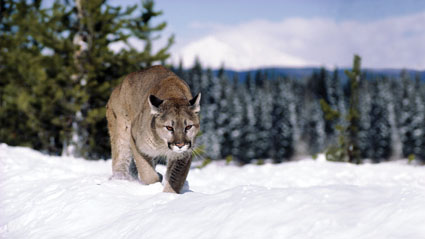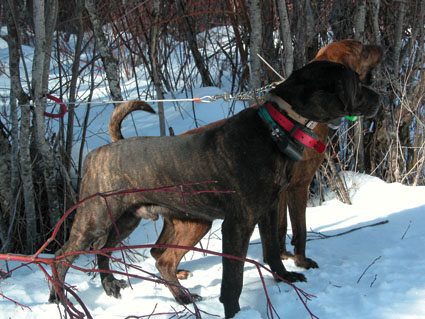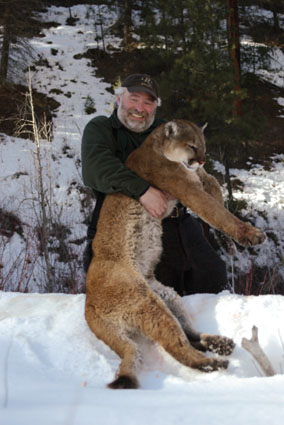 It’s All In The Track
It’s All In The Track
When hunting mountain lions, track is everything. It must be left by a large lion and must be fresh enough for dogs to follow with a good chance of catching up to the cat. It sounds simple in theory, but cat hunting requires smarts, persistence and a lot of luck. The first two are easy, but the luck part – that’s the unknown. On this hunt, luck seemed to be running out fast.
We were six days into a seven-day mountain lion hunt and so far it was nothing but frustration. At first it had been day after day of riding snowmobiles along trails looking for tracks. A child of the North Country, I loved it – the cold, exploring new places, the feel of a powerful machine under me, the excitement of discovery mixed with the thrill of speed. But that faded as the hunting time leached away without spotting a single viable cat track.
Worse were the later days when the outfitter started feeling the pressure. We were left behind in the truck to wait while the guides took off with snowmobiles to look for tracks. Their rationale was that it was a “short loop” and it didn’t make sense to unload all the machines and the dogs... We stayed behind to guard the dogs, while they looked for tracks. Those “short loops” often meant we waited in a cold, boring truck for five or six hours, so when the opportunity came to ride again, I jumped on it. Looking for tracks was part of the hunt and I did not feel like a hunter without participating.
By Any Name
The mountain lion is also known as the cougar, panther, catamount, puma and enough other names to make it the critter with the most aliases in all of North America. In English alone, there are at least 42 names for this cat. Throw in Indian and Spanish names and it reaches over 100 nom de plumes. On each day of this hunt that passed without success, I added several more to the list.
 The Latin name for the mountain lion is Felis (cat) concolor (of one color) and it was given to it by Carl Linnaeus in 1771. Carl Linnaeus was also known as Carl von Linné or Carolus Linnaeus and he is often called the Father of Taxonomy, so the mountain lion’s legal name tracks from a lofty lineage.
The Latin name for the mountain lion is Felis (cat) concolor (of one color) and it was given to it by Carl Linnaeus in 1771. Carl Linnaeus was also known as Carl von Linné or Carolus Linnaeus and he is often called the Father of Taxonomy, so the mountain lion’s legal name tracks from a lofty lineage.
The mountain lion is a highly efficient predator. A full grown male lion can be 7 to 9-1/2 feet long, stand 26 to 31 inches high at the shoulder and weigh up to 275 pounds. There are reports of lions reaching over 300 pounds. Although such giants are rare, it’s not unusual in many locations for a male to exceed 200 pounds. That’s a lot of predator. Their primary food source is deer and an adult mountain lion will kill one to three deer per week.
Female lions usually first reproduce at about two and a half years of age, and generally have two or three kittens. A mountain lion's life span is estimated at an average of 12 years in the wild, and each lion’s home range will average 60 to 70 miles or more in any direction. The lion is like a domestic cat in that it will kill for the sake of killing, and may kill many more animals in an attack than it can possibly consume. There are reports of lions killing 20 or more sheep at a time, with every reason to expect that they do the same with deer when they can.
Add wolves to the mix and lions must kill even more. Biologists have found that wolves often chase a lion off its kill and consume it, forcing the lion kill again, which might explain why we were seeing far more wolf tracks than lion tracks during this hunt. Like other pack predators, (city street gangs come to mind) wolves have discovered that it’s far easier to steal what others have than to earn it yourself.
Just Another Meal
Given these facts, it doesn’t take a genius to understand that without checks and balances the mountain lions will rapidly overpopulate. It also doesn’t take a rocket scientist to understand the deer population cannot withstand that kind of a lion population explosion. Lions use almost as much energy to kill a squirrel as a deer, so when deer populations drop, they logically turn to killing other large animals. As a result, elk and moose populations suffer, as do livestock, family pets and people.
It used to be lion attacks on humans were rare, but now we are just another meal. From 1900 to the late 1980s, lion attacks were rare. But things changed, and through the 1990s and into this century, attacks on humans have become all too common. These are not limited to the “sick and weak” lions as their apologists would have you believe, they are often healthy and hungry cats that have come to realize humans do not pose a threat anymore.
 Why did it change? Simple, a misguided society pressured hunting, trapping and other control measures to back off lions. That resulted in a population explosion, which depleted the natural food and expanded the lion’s range further from the wilderness and well into human habitat. We also give the lions more opportunity with an influx of naive and unprepared people entering the cat’s hunting zones. For example, after California banned mountain lion hunting, it didn’t take the lions long to figure out that joggers and bicycle riders were easy prey. (Take note that they, for the most part, leave hunters alone. They can recognize a bicyclist as easy pickings, and that hunters fight back. Smart critters, these lions.)
Why did it change? Simple, a misguided society pressured hunting, trapping and other control measures to back off lions. That resulted in a population explosion, which depleted the natural food and expanded the lion’s range further from the wilderness and well into human habitat. We also give the lions more opportunity with an influx of naive and unprepared people entering the cat’s hunting zones. For example, after California banned mountain lion hunting, it didn’t take the lions long to figure out that joggers and bicycle riders were easy prey. (Take note that they, for the most part, leave hunters alone. They can recognize a bicyclist as easy pickings, and that hunters fight back. Smart critters, these lions.)
The Sound Of The Hounds
I have my own reasons for hunting cats and many center around hounds. In my youth, I owned hounds for hunting rabbits, snowshoe hares and coons. Later I spent a lot of time chasing black bears with hounds. In the 1990s, we added the winter sport of running coyotes with walker hounds, and I now make it a practice to never let a year pass without hearing the hounds on the track of something. If you are a dog hunter you understand. If you are not, trust me when I say there is something primal in the chase, something that will stir the soul of any true hunter. Man has used dogs to hunt for eons and the partnership has advanced both species. This symbiotic relationship has become imbedded in our genetic makeup, suppressed in modern times, but eager to resurface any time dogs strike a hot track and break into full cry. That’s what lion hunting is all about and it’s the hound’s chaotic music I was craving.
Any great hunting trip is filled with emotional highs and lows. I was trying to be upbeat on this one, but with little success. Day after day, we hit the wilderness at daybreak and looked for a viable track until mid-afternoon. By then it’s too late to turn the dogs loose. The chances of dark overcoming the chase before its conclusion are far too great. At best, it means the dogs are too tired to hunt the next day, at worst it ends with the lions killing valuable dogs. Each day we pushed the deadline a little later, but even with that we would pack up the snowmobiles and the dogs while the sun was still high and head back to the camp. I wanted to be out, searching, hunting, doing something, but instead we waited for the morning that was so long in coming. I remember once, hunting in Russia, seeing a wolf that had been trapped and was now in a small cage. He paced endlessly back and forth, restless, remembering his freedom and dealing poorly with his confinement. Each afternoon and evening I felt like that wolf.

The Sound Of Success
Finally, late in the morning on the sixth day I heard the dogs. They struck a track and their sweet music filled the mountains and valleys to full capacity. With that, my soul rose from the dead and I was again a hunter. I have chased bears and coyotes for mile after mile with the hounds, but mountain lions are not noted as long distance runners, and this ancient cat was too arthritic and old to disprove that. But, it did pick the top of the steepest slope in country dominated by steep slopes to make a stand.
We parked at the bottom, dumped gear and started the climb. The snow was deep, old and evil. It was crusted on top in the most devious of ways, supporting me long enough to make me think it was real, then a foot would plunge through, burying my leg to the hip and planting my face hard on the icy surface. Cussing didn’t help and rage made nothing better, but I tried both anyway. Then, I would wipe ice and blood from my face, climb back on top and continue my assent. I was starting to understand how Sisyphus must have felt as he pushed his rock always higher, but never reaching his goal before it fell back to the bottom. The rock I pushed was my aging and overweight body. My goal was the tree the lion had climbed, but like Sisyphus I felt I would never fully succeed. It did me well and was inspirational to look back and see men that I had by twenty years, forty pounds and one heart attack struggling behind me. It gave me courage, power and wings. All the while the furious “treed” barking of the hounds gave me focus and a goal.
It’s expected for me to say at this point that shooting the cat was “anti-climatic,” but I will not. The adrenaline rush, the excitement, the anticipation and the thrill was in no way less than it might be if I were the one perched in the tree and the cat was a big whitetail slinking underneath. Every hunting method has its attraction, its detractions, and its thrills, and mountain lions with hounds are no exception. Those who have never done it will criticize smugly from their limited base of experience and dismiss it as non-sporting. But, their ignorance is evident to those lucky souls who have experienced the thrill of the chase, the music of the hounds and the climatic and exciting end to a lion hunt.
Table Mountain Outfitters
(307) 632-6352






